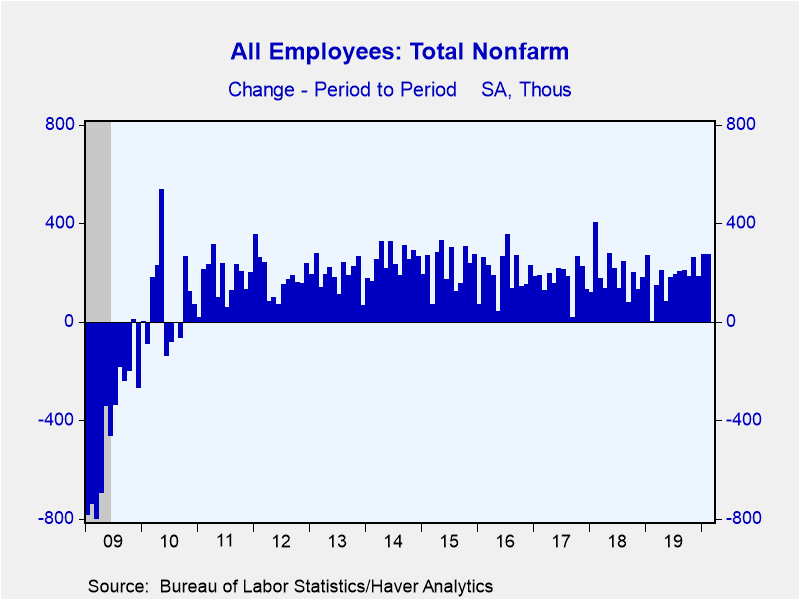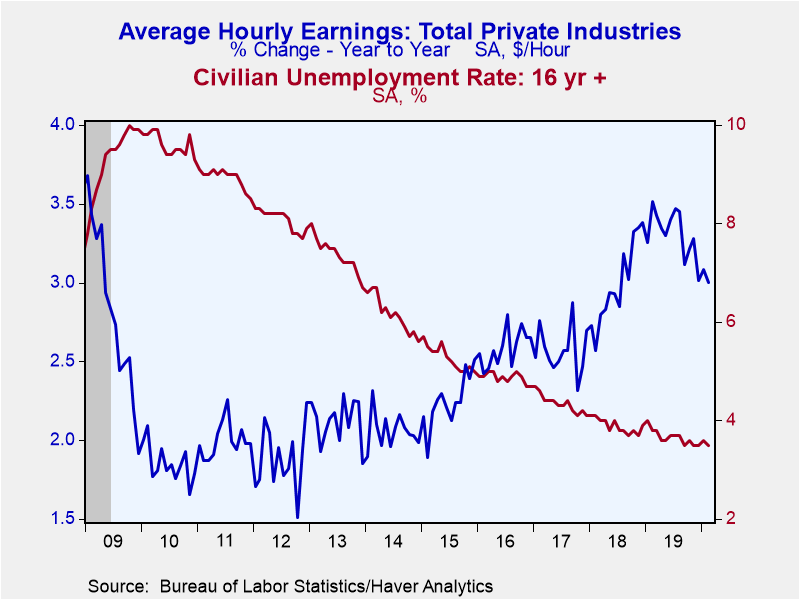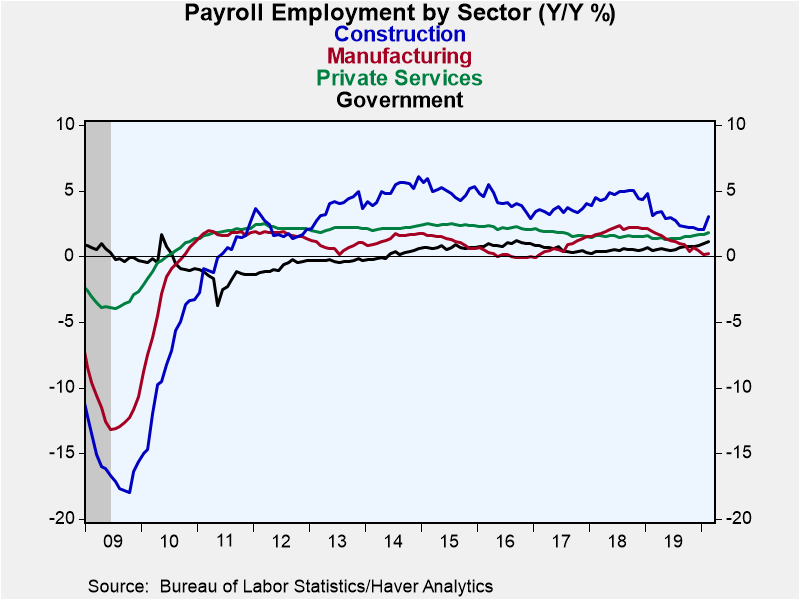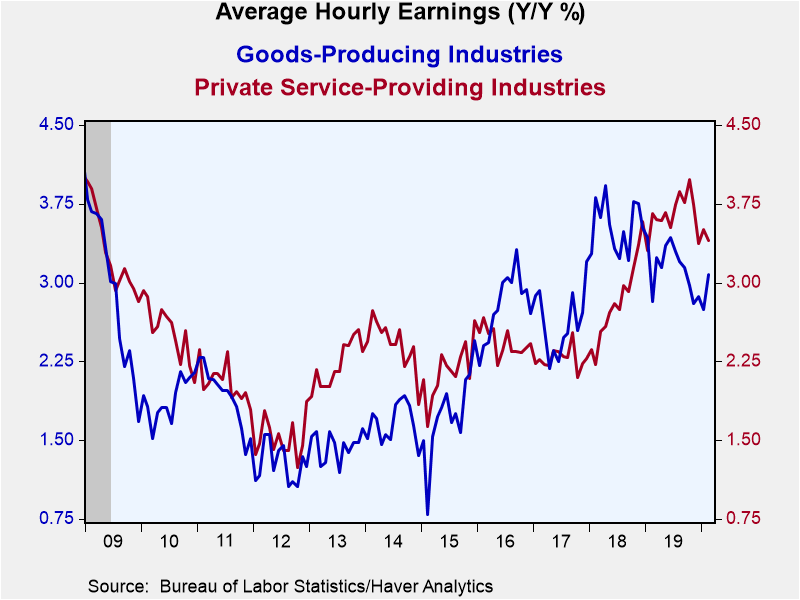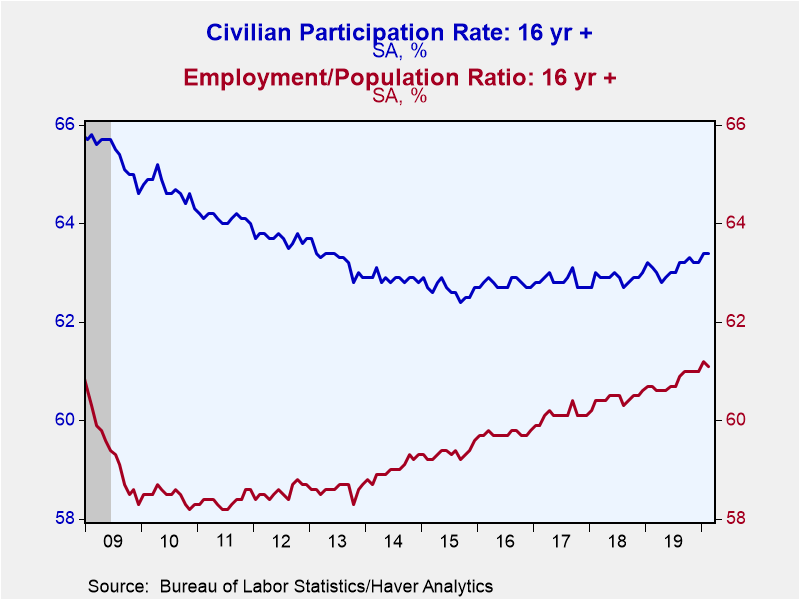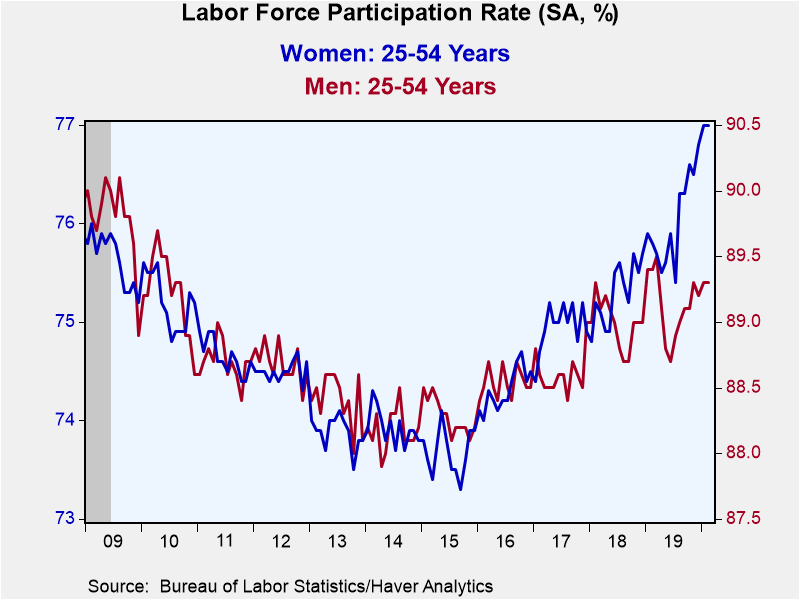 Global| Mar 06 2020
Global| Mar 06 2020U.S. Nonfarm Payrolls Show Unexpected Strength Ahead of Coronavirus Outbreak; Wages Improve & Unemployment Dips
by:Tom Moeller
|in:Economy in Brief
Summary
The job market firmed in February. Nonfarm payroll employment increased 273,000 (1.6% y/y), repeating January's increase which was revised from 225,000. The December increase also was upwardly revised to 184,000 from 147,000. A [...]
The job market firmed in February. Nonfarm payroll employment increased 273,000 (1.6% y/y), repeating January's increase which was revised from 225,000. The December increase also was upwardly revised to 184,000 from 147,000. A 170,000 increase had been expected in the Action Economics Forecast Survey.
Average hourly earnings in the private sector rose an expected 0.3% following an unrevised 0.2% January improvement. Growth of 3.0% y/y remained below its 12-month peak of 3.5%.
The unemployment rate declined to 3.5% in February. Stability at 3.6% had been expected. Employment in the household survey rose 45,000, but the labor force declined 60,000. The overall jobless rate, including those who were marginally attached or working part-time for economic reasons, increased to 7.0%, its highest level in six months.
From the payroll survey of employment, the 273,000 increase in jobs reflected a 42,000 increase in construction which followed a 49,000 gain. These increases were by far the largest since early last year. Factory sector employment increased 15,000 following declines in three of the prior four months. Mining & logging sector jobs improved 4,000 (-4.0% y/y), the first increase since October.
The number of private service jobs rose 167,000 led by a 54,000 rise (2.7% y/y) in education & health services which came after a 72,000 jump. Leisure & hospitality employment gained 51,000 (2.6% y/y) which was the largest rise since October. The number of professional & business services jobs increased 41,000 (2.0% y/y) which also was the largest rise in four months. Temporary help positions declined 3,300 (-1.0% y/y). A 26,000 gain (1.9% y/y) in financial sector employment was by far the largest increase in two years. Trade, transportation & utilities employment declined 13,000 (+0.4% y/y) as the number of retail jobs fell 7,000 (-0.2% y/y).
In the public sector, jobs increased 45,000 (1.0% y/y) after a 51,000 January gain. Together, these were the largest increases in ten years. The latest increase was led by a 19,000 surge (1.0% y/y) in local employment. State government employment also was strong, rising an increased 18,000 (0.7% y/y). Federal government jobs improved a strengthened 8,000 (1.6% y/y).
The improved 0.3% rise (3.0% y/y) in average hourly earnings was led by a 0.7% strengthening (3.9% y/y) in financial services pay. Professional & business services earnings gained 0.4% (3.7% y/y) and leisure & hospitality earnings rose a steady 0.3% (3.0% y/y). Construction earnings increased 0.4% (3.0% y/y), the largest increase in three months. Mining & logging sector pay rose 0.5% and a strengthened 4.8% y/y, while factory sector earnings inched 0.1% higher (2.8% y/y).
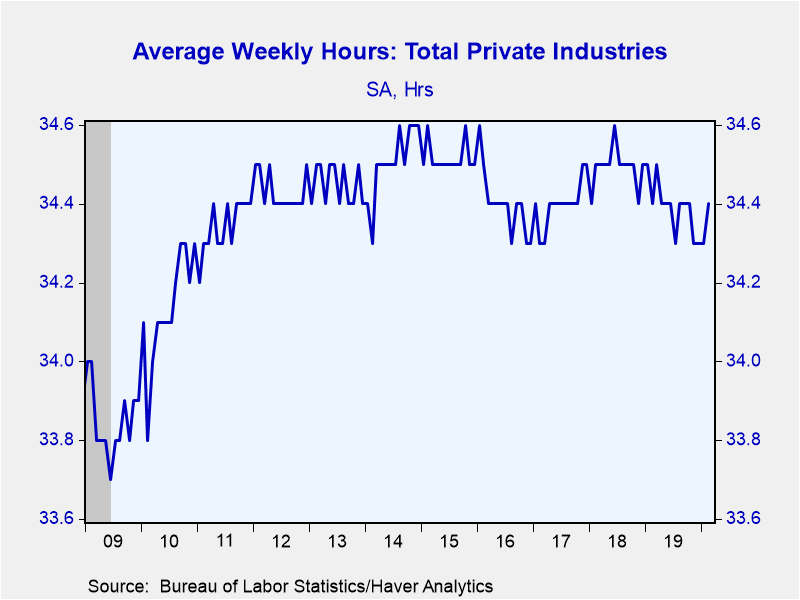 The length of the average workweek improved slightly m/m to 34.4 hours but
remained below the June 2018 peak of 34.6 hours. The mining & logging sector
workweek eased to 45.6 hours, but the factory sector workweek lengthened
to 40.7 hours. The construction sector workweek increased slightly
to 39.3 hours. In the private service sector, the number of hours-worked rose to
33.3. That reflected an easing in financial activities to 37.6 hours, but
professional & business services rose to 36.2 hours. The length of the
workweek in education & health services rose to the May 2008 record of 33.1
hours. Leisure & hospitality hours eased to 25.8, matching the fewest since 2013.
The length of the average workweek improved slightly m/m to 34.4 hours but
remained below the June 2018 peak of 34.6 hours. The mining & logging sector
workweek eased to 45.6 hours, but the factory sector workweek lengthened
to 40.7 hours. The construction sector workweek increased slightly
to 39.3 hours. In the private service sector, the number of hours-worked rose to
33.3. That reflected an easing in financial activities to 37.6 hours, but
professional & business services rose to 36.2 hours. The length of the
workweek in education & health services rose to the May 2008 record of 33.1
hours. Leisure & hospitality hours eased to 25.8, matching the fewest since 2013.
From the household employment survey, the decline in the unemployment rate to 3.5% returned it to the 50-year low. The decline in the labor force reflected a steady labor force participation rate of 63.4%. That remained increased from the September 2015 low of 62.4%. The teenage participation rate returned to a 12-year high of 36.4%, and for those aged 20-24, it held steady at an increased 72.9%. For workers aged 25-54, the rate eased from the 2008 average high of 83.1% to 83.0%. For men in that age bracket, the rate held steady at 89.3%. For women of that age, it held at 77.0%, the highest rate since 2000 and up from an average 73.7% during all of 2015. For workers aged 55 & over, the participation rate remained at an elevated 40.3%, and was increased from 29.4% in 1993. The employment/population ratio eased m/m to 61.1%, but remained up from 58.4% in 2011.
The average duration of unemployment slipped to 20.9 weeks, roughly half what it was at its high in 2011.
The teenage unemployment rate fell sharply to 11.0%, well below the 25.9% averaged in 2010. The rate for workers aged 20-24 of 6.4% was less than half the 15.5% average in 2010. For workers aged 25-54, the steady rate of 3.0% was down from 8.6% in 2010. For those over 55, the jobless rate of 2.6% compared to 7.0% in 2010.
By educational attainment, unemployment of workers without a high school diploma rose to 5.7%, its highest level in roughly one year. High school graduates without a college degree were a lessened 3.6% unemployed and those with some college but no degree were a slightly higher 3.0% without work. College graduates were 1.9% unemployed, equaling the least since 2007.
The labor market data are contained in Haver's USECON database. Detailed figures are in the EMPL and LABOR databases. The expectations figures are in the AS1REPNA database.
| Employment: (SA, M/M Change, 000s) | Feb | Jan | Dec | Feb Y/Y | 2019 | 2018 | 2017 |
|---|---|---|---|---|---|---|---|
| Payroll Employment | 273 | 273 | 184 | 1.6% | 1.4% | 1.6% | 1.6% |
| Previous Estimate | -- | 225 | 147 | -- | -- | -- | -- |
| Manufacturing | 15 | -20 | -2 | 0.2 | 1.2 | 2.0 | 0.7 |
| Construction | 42 | 49 | 16 | 2.9 | 2.8 | 4.6 | 3.6 |
| Private Service-Producing | 167 | 195 | 159 | 1.8 | 1.4 | 1.5 | 1.8 |
| Government | 45 | 51 | 20 | 1.0 | 0.6 | 0.5 | 0.4 |
| Average Weekly Hours - Private Sector | 34.4 | 34.3 | 34.3 | 34.4 | 34.4 | 34.5 | 34.4 |
| Private Sector Average Hourly Earnings (%) | 0.3 | 0.2 | 0.1 | 3.0 | 3.3 | 3.0 | 2.6 |
| Unemployment Rate (%) | 3.5 | 3.6 | 3.5 | 3.8 | 3.7 | 3.9 | 4.3 |
Tom Moeller
AuthorMore in Author Profile »Prior to joining Haver Analytics in 2000, Mr. Moeller worked as the Economist at Chancellor Capital Management from 1985 to 1999. There, he developed comprehensive economic forecasts and interpreted economic data for equity and fixed income portfolio managers. Also at Chancellor, Mr. Moeller worked as an equity analyst and was responsible for researching and rating companies in the economically sensitive automobile and housing industries for investment in Chancellor’s equity portfolio. Prior to joining Chancellor, Mr. Moeller was an Economist at Citibank from 1979 to 1984. He also analyzed pricing behavior in the metals industry for the Council on Wage and Price Stability in Washington, D.C. In 1999, Mr. Moeller received the award for most accurate forecast from the Forecasters' Club of New York. From 1990 to 1992 he was President of the New York Association for Business Economists. Mr. Moeller earned an M.B.A. in Finance from Fordham University, where he graduated in 1987. He holds a Bachelor of Arts in Economics from George Washington University.


